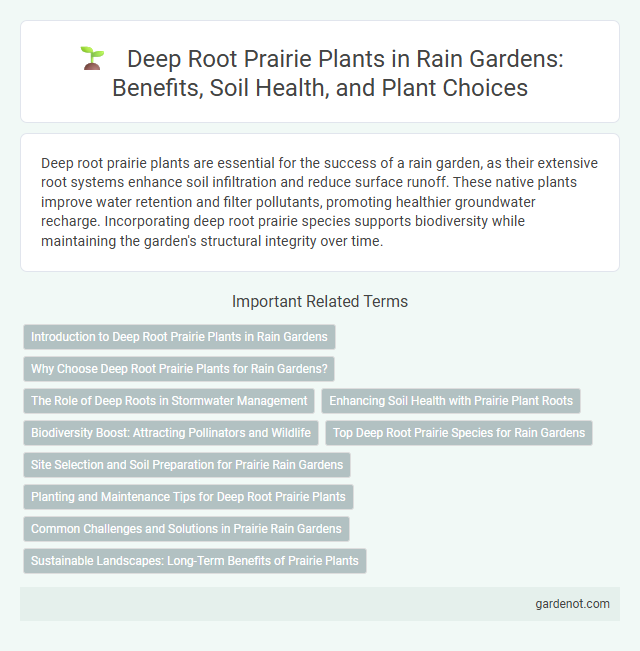Deep root prairie plants are essential for the success of a rain garden, as their extensive root systems enhance soil infiltration and reduce surface runoff. These native plants improve water retention and filter pollutants, promoting healthier groundwater recharge. Incorporating deep root prairie species supports biodiversity while maintaining the garden's structural integrity over time.
Introduction to Deep Root Prairie Plants in Rain Gardens
Deep root prairie plants in rain gardens effectively support stormwater management by enhancing soil infiltration and reducing runoff. These native species, such as little bluestem, purple coneflower, and switchgrass, develop extensive root systems that stabilize soil and improve groundwater recharge. Their drought tolerance and adaptability also contribute to sustainable rain garden ecosystems.
Why Choose Deep Root Prairie Plants for Rain Gardens?
Deep root prairie plants are ideal for rain gardens because their extensive root systems enhance soil infiltration and reduce surface runoff, promoting efficient stormwater management. These plants improve soil structure by increasing porosity and organic matter, which helps filter pollutants and supports groundwater recharge. Their deep roots also provide stability, preventing erosion and creating a resilient rain garden ecosystem that thrives in variable moisture conditions.
The Role of Deep Roots in Stormwater Management
Deep root prairie plants significantly enhance stormwater management by improving soil infiltration and reducing surface runoff. Their extensive root systems stabilize soil, increase water absorption, and promote groundwater recharge, effectively mitigating flood risks in urban rain gardens. These deep roots also filter pollutants, enhancing water quality while supporting resilient, sustainable landscapes.
Enhancing Soil Health with Prairie Plant Roots
Deep root prairie plants significantly enhance soil health by increasing organic matter and promoting soil aeration through their extensive root systems. Their deep roots improve water infiltration and retention, reducing erosion and supporting microbial activity essential for nutrient cycling. This natural soil enhancement leads to more resilient landscapes and healthier ecosystems within rain gardens.
Biodiversity Boost: Attracting Pollinators and Wildlife
Deep root prairie plantings in rain gardens significantly boost biodiversity by providing essential habitat and nectar sources for pollinators such as bees, butterflies, and hummingbirds. Their extensive root systems enhance soil health and water infiltration, supporting a diverse array of wildlife including birds and beneficial insects. This ecological synergy fosters a balanced ecosystem that improves local environmental resilience and promotes sustainable urban green spaces.
Top Deep Root Prairie Species for Rain Gardens
Top deep root prairie species for rain gardens include switchgrass (Panicum virgatum), big bluestem (Andropogon gerardii), and Indian grass (Sorghastrum nutans), all known for their extensive root systems that enhance soil infiltration and water retention. These native grasses thrive in variable moisture conditions, promoting resilience in rain garden ecosystems while supporting local biodiversity. Incorporating deep-rooted species improves sediment filtration and reduces runoff, making rain gardens more effective in managing stormwater.
Site Selection and Soil Preparation for Prairie Rain Gardens
Site selection for deep root prairie rain gardens requires well-drained soils with good infiltration rates, ideally sandy loam or loamy soils that support native prairie grasses and wildflowers. Soil preparation involves minimal disturbance to maintain soil structure and organic matter, with amendments like compost added to enhance nutrient availability and promote deep root growth essential for stormwater absorption. Choosing locations away from heavy shade and compacted areas ensures optimal plant establishment and effective rainwater management.
Planting and Maintenance Tips for Deep Root Prairie Plants
Plant deep root prairie plants in well-drained soil with full to partial sunlight to encourage robust root development and drought resilience. Mulch around plants to retain moisture and suppress weeds, while avoiding excessive watering that can lead to root rot. Regular maintenance includes seasonal pruning to remove dead foliage and promote healthy growth, as well as monitoring for invasive species to preserve native biodiversity.
Common Challenges and Solutions in Prairie Rain Gardens
Deep root prairie plants in rain gardens often face challenges such as poor soil drainage, competition from invasive species, and drought stress. Solutions include amending soil with organic matter to improve permeability, regularly monitoring and removing invasive plants, and selecting drought-tolerant native prairie species like little bluestem and purple coneflower. Establishing deep root systems enhances water infiltration and supports long-term garden resilience.
Sustainable Landscapes: Long-Term Benefits of Prairie Plants
Deep root prairie plants enhance sustainable landscapes by improving soil health and increasing water infiltration through their extensive root systems, which can reach depths of up to 10 feet. These robust roots stabilize soil, reduce erosion, and support biodiversity by providing habitat for native pollinators and wildlife. Integrating prairie plants into rain gardens promotes long-term ecological resilience and reduces reliance on irrigation and chemical inputs.
Deep root prairie Infographic

 gardenot.com
gardenot.com